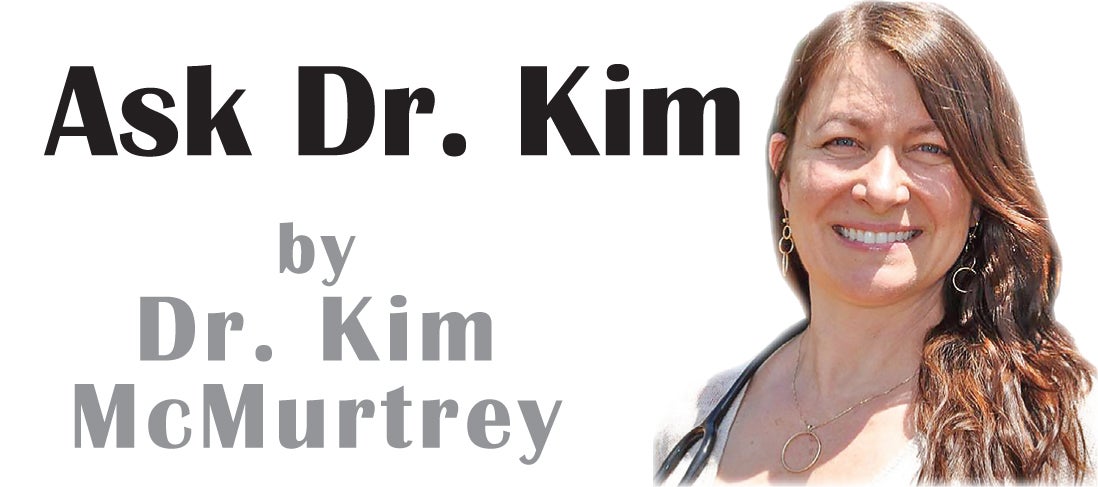Headaches decoded
Published 11:56 am Friday, June 5, 2020
|
Getting your Trinity Audio player ready...
|
Q: Hi Dr. Kim,
My question for you is about headaches. When I have a headache, it is only in one spot on my forehead and I always have an upset stomach at the same time. My sister always has them on the back of her head, without an upset stomach. What is going on, here? Thanks for any info you may have. — Kevin from Elizabethton
A: Hi Kevin,
Thanks for your question. To get a diagnosis, you would need to be evaluated separately. But the short answer is, you are suffering from two different types of headaches. Headaches and even migraines can appear to run in families. The American Migraine Association reports that if both parents have migraines, there is a 50-70% chance that a child will too. You reported that your sister was having headaches. If you both have them often, it could be a case of chronic headache and familial headache. Chronic headache is long term and familial headache seems to be inherited or it happens when family members experience headaches often. A headache is considered chronic if you have more than 15 headache days per month (according to the US National Library of Medicine). If you have headaches that seem often, occur regularly, or interfere with your quality of life, I consider them a treatable problem. Headaches or migraines, no one should have to live with them.
In our modern understanding of health, headaches are often ignored or brushed aside as “normal”. I promise that though they are common, they are not normal, and a headache is a sign that something is off. The simple explanation: Your headache means something, and different types of headaches have different characteristics.
Headache describes any general pain in the head, especially when it is not from an external cause (such as an injury to the head). Migraine is a severe headache that comes with other symptoms at the same times, such as nausea, sensitivity to light and sound, extreme fatigue, malaise, dizziness, confusion, or “aura”. Three keys to describe a migraine are: throbbing pain, sensitivity, and vision changes. A common characteristic of migraines is that they occur on one side of the head and are often repeated in the same area. Women experience migraines more often than men, and men get cluster headaches more often than women. Anyone can get any type of headache, and statistics alone do not define the headache types.
Aura describes symptoms like: blurry vision, blind spots, numbness, visual disturbance or loss of balance, disorientation, or inability to speak.
The different types of headaches depend on the location, characteristics, and symptoms that accompany it. The more you know about your headache, the more likely that you and your healthcare professional can pinpoint the root cause and help you avoid them in the future. Let’s look at the different types.
Sinus headache: Pain is on the face, behind the brow line, on the cheeks, or both. A sinus headache is often accompanied by congestion, phlegm, coughing, sneezing, fatigue or fever, and sinuses sensitive to touch pressure, discharge from the nose or a stuffy nose.
Cluster headache: Intense pain around one eye. This eye may become red and have tears. One eyelid drooping and sweating of the face is considered a severe cluster headache. It is possible for this headache to change sides and reoccur at a certain time of year.
Tension headache: Feels like a headband or like something squeezing the head. Tension headaches are triggered by stress, inadequate sleep, and poor posture.
Neck tension headache: Back of the head or beginning in the neck. Headaches that began in the neck may also reach as far down as the shoulder.
TMJ headache: Pain is at the temples, around or in front of the ears. May be accompanied by neck or jaw pain and a tight or “locked” jaw. Usually accompanies TMJ syndrome or long term problems with the jaw.
Headache can also be a symptom originating from another health condition. For example, Neck tension headaches can indicate spasm of the neck muscles or misaligned vertebrae. Classical Oriental Medicine contains a long tradition of treating headaches from all kinds of causes.Though the system of diagnosis differs from that of modern medicine, the insight remains. Here, I described the different headache types in terms of the acupuncture meridian.
• Headache on the Forehead: Spleen/Stomach energy disrupted (digestive headache)
• Sides of the head: The Gallbladder or Triple Burner meridians blocked or Liver chi stagnation
• Top of the head: Liver Yang Rising (stress, anger, or internal body inflammation)
• Back of the head: Bladder meridian blocked, or Wind Cold Invasion (onset of a cold)
• In the eyes: Problem of a meridian, usually the Stomach, Bladder, or Gallbladder.
• All over the head: Chi deficiency (lack of vital body energy) or Blood deficiency (the closest in modern medicine would be borderline anemia or lack of nutrition).
• In one spot only: Stagnation of blood or chi (lack of circulation)
Now, if you are familiar with the different types of headaches, it will help to be aware of the most common causes and contributing factors to them. These are: Stress, lack of hydration, fatigue due to overwork, lack of nutrition, lack of sleep, too much screen time (phones and computer screens especially strain the fine muscles of the eyes and neck), medication interactions, hormones, exposure to toxins, allergens, or endocrine-disruptive chemicals, drug or alcohol use or withdrawal, genetics, environmental (such as barometric pressure change before a storm), and underlying health conditions.
A headache is a classic sign that something is out of balance in your life. They are warning signs from the body. If you are experiencing headaches it is important to get help sooner rather than later so that you can find the root cause and feel better faster. It may be important to evaluate the foods that you are eating, your level of stress, and lifestyle habits. Changing one’s lifestyle is not something I think of as work or as a punishment, but a way to keep yourself well over the long term and give your health and happiness the attention they deserve.





